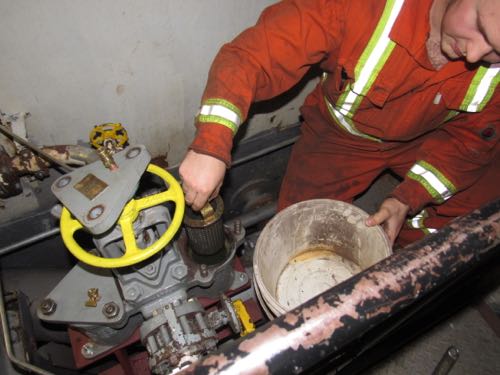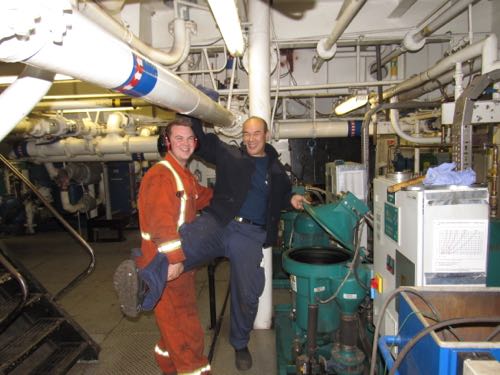News Update
 Present location of the CCGS Louis S. St-Laurent.
Present location of the CCGS Louis S. St-Laurent.
We are on an easterly run towards station PP6 then will turn back towards the northwest heading for stations PP7 and CB15. By days end we expect to be heading directly north towards station CB16 and then farther north possibly as far north as 83˚N (only 7 degrees or 777 km or 486 miles from the North Pole!) in search of suitable ice for the first "ice ops" station. We had a mishap with the rosette frame. The rosette frame extension, added this year, imploded at the depth of 3600 meters. Turns out that there was no way for the air inside the tube to escape so under the large pressure differential of being at 3600 meters the hollow tube imploded (see the two photos below).
 Josh Mitchell (WHOI) inspects the imploded rosette frame.
Josh Mitchell (WHOI) inspects the imploded rosette frame.
 A portion of the imploded rosette frame. Notice the curve of the metal indicating failure of the metal tubing inward.
A portion of the imploded rosette frame. Notice the curve of the metal indicating failure of the metal tubing inward.
I got to spend quite a bit of time in the engine room yesterday with a couple of the Oilers, Sheridan Rice and Dylan Mehaney. These two spend their days in the engine room ending to mostly routine maintenance tasks. They know every inch of the engine room like the back of their hands. The power train of this little city on water is in the engine and is made up of 5 diesel generators and the 3 DC electric motors that turn the three screws thereby propelling the ship. For you motor-heads out there, the diesel generators are massive twin turbo, 16 cylinder engines capable of producing 8000 horsepower each... yeeha! Probably overkill for your F-250 pick-em-up truck. When in heavy ice, as many as four of the engines will be on at once combining with the electric motors to produce 27,000 horsepower at the screws. The diesel electric system is actually the second power system installed on the Louis. The first was a steam electric system that burned fuel oil to generate steam, which then was used to generate the electricity for the electric motors. The diesel-electric refit is much more fuel-efficient and gives the ship a greater travel distance with out needing to refill the fuel tanks. Here are a couple of engine room photos.
 Sheridan Rice, crew member of CCGS Louis S. St. Laurent applies some grease to the rudder guide.
Sheridan Rice, crew member of CCGS Louis S. St. Laurent applies some grease to the rudder guide.
 Sheridan Rice, crew member of CCGS Louis S. St. Laurent pulls one of the oil strainers for routine cleaning.
Sheridan Rice, crew member of CCGS Louis S. St. Laurent pulls one of the oil strainers for routine cleaning.
 The Engine Room crew getting it done!
The Engine Room crew getting it done!
Chemistry Timeout
Alrighty... more on carbon dioxide. So we established that the reaction CO2 + H20 ––> H2CO3 is the origin of the carbonate ion so what happens next?? The H2CO3 is known, in chemistry speak, as carbonic acid (as in "the acid of carbonate"). Carbonic acid has a tendency to break up or "disassociate" into hydrogen ions (H+) and carbonate ions (CO32-). The equation for this is: H2CO3 ––> 2H+ + CO32-. We put a 2 in front of the H+ to indicate that there are two hydrogen ions formed. But there is more.... and we'll get to that next time.
Crew Member Focus
The outgoing and always smiling Wilfred Parsons hales from Rose Blanche, Newfoundland, has 2 daughters and 4 grandchildren. He is a Deckhand and Quartermaster on the Louis S. St Laurent. Prior to coming to the Coast Guard, he has had a variety of jobs including fishing and working on the BC Oil patch for 5-6 years. He says he loves the work with the Coast Guard for several reasons: it's physical, likes being on the sea, gets to help other people out, and having large blocks of time to pursue his outside interests. Some of those interests include being a self-taught musician, and hunting for bear, moose, and ducks.
 Wilfred Parsons poses for a photo on board the CCGS Louis S. St. Laurent.
Wilfred Parsons poses for a photo on board the CCGS Louis S. St. Laurent.
 Wilfred Parsons helps the Science crew out by launching an XCTD unit. The X (expendable) CTD is used while the ship is underway to validate the rosette CTD data.
Wilfred Parsons helps the Science crew out by launching an XCTD unit. The X (expendable) CTD is used while the ship is underway to validate the rosette CTD data.
Geo-engineering methods to improve Arctic Climate (cooling down)
In the 1970s, Mikhail Budyko suggested dispersing in the atmosphere sulferous aerosols to reflect some of the solar radiation back into space thereby reducing global warming. There are two basic technologies in the geo-engineering literature to reduce climate warming, namely: carbon capture and sequestration (CCS) and solar radiation management (SRM). These proposed techniques were reviewed by the Committee on Geo-engineering Climate and it was concluded that no technique is completely effective or risk-free.
An interesting paper, recently published by scientists from the University of Arizona (S. Desch et al. Arctic ice management. Earth’s Future. Vol. 5, January 24, 2017, p. 107), concluded that it is unlikely that CO2 levels and mean temperatures can be decreased in time to prevent Arctic ice loss and proposed to restore sea ice artificially. Their idea is to enhance Arctic sea ice production by using wind power during the Arctic winter to pump water to the surface, where it will freeze more quickly than underneath of the ice, where it usually forms. They demonstrate that it is possible to increase ice thickness above natural levels, by about 1 m over the course of the winter. They propose that winter ice thickening by wind-powered pumps could be considered and assessed as part of a multi-pronged strategy for restoring sea ice in the climate system.
They estimate that if the wind-powered pumps are to be distributed across 10% of the Arctic’s ice covered area, would necessitate about 10 million wind-powered pumps. If distributed across the entire Arctic, about 100 million of pumps would be needed. The implementation of their plan over 10 years (to get climate cooling effect) would cost $500 billion per year for the entire Arctic, or $50 billion per year for 10% of the Arctic. Even $500 billion per year represents only 0.64% of current world gross domestic product (GDP) of $78 trillion; 2.7% of the current U.S. GDP of $18.5 trillion, or 13% of the current U.S. federal budget of $3.8 trillion.
From the oceanographic view point and based on our project studies and results there is at least one problem which was not discussed in this proposal. The problem is that the removal of 1 meter of fresh water from the surface layer of the Arctic Ocean (sea ice is actually a very low salinity water) will reduce upper ocean water stratification (similar to the effect of reversal of Siberian rivers discussed in our dispatch #2) and will result in the release of a lot of heat from the deep layers of the Arctic Ocean which would melt sea ice accumulated during winter. It is clear that the proposed idea has to be checked employing different Arctic climate models.
 Schematic showing how the Arctic sea ice production could be enhanced by using wind power power during the Arctic winter to pump water to the surface, where it will freeze more rapidly than at the bottom surface of sea ice. Prepared by Andrey Proshutinsky.
Schematic showing how the Arctic sea ice production could be enhanced by using wind power power during the Arctic winter to pump water to the surface, where it will freeze more rapidly than at the bottom surface of sea ice. Prepared by Andrey Proshutinsky.

Add new comment